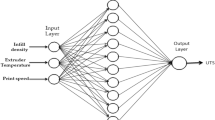Abstract
In this research, results of an experimental and artificial neural network fuzzy interface system (ANFIS) modeling of operating parameters on tensile strength of the carbon fibers are investigated. To do these experiments, the commercial polyacrylonitrile (PAN) fiber of Polyacryl Iran Corporation (PIC) was used as the precursors. The results show that increasing all of parameters improves tensile strength performance. ANFIS was applied to predict tensile strength of carbon fibers as a function of stabilization temperature at first stage (STFIS), stabilization temperature at second stage (STSS), stabilization temperature at third stage (STTS), stabilization temperature at fourth stage (STFOS), and carbonization temperature (CT). The optimum levels of influential factors, determined for tensile strength are STFIS 200 °C, STSS 225 °C, STTS 240 °C, STFOS 260 °C, CT, and 1400 °C. The modeling results showed that there is an excellent agreement between the experimental data and the predicted values. Furthermore, the fiber process is optimized applying differential evolution (DE) algorithm as an effective and robust optimization method.
Similar content being viewed by others
References
Z. Wangxi, L. Jie, and W. Gang, Carbon, 41, 2805 (2003).
H. Ahmadi Danesh Ashtiani, and R. Eslami Farsani, Fiber Polym., 12, 1054 (2011).
Z. Wangxi, L. Jie, and W. Gang, Carbon, 41, 2805 (2003).
M. A. Montes-Mor’an, W. Gauthier, and A. Mart’inez-Alonso, Carbon, 42, 1275 (2004).
M. Trinquecoste, J. L. Carlier, A. Derrb, and P. Delhaes, Carbon, 34, 923 (1996).
A. Sedghi, R. EslamiFarsani, and A. Shokuhfar, J. Mater. Process. Technol., 198, 60 (2008).
M. S. A. Rahaman, A. F. Ismail, and A. Mustafa, Polym. Degrad. Stab., 92, 1421 (2007).
F. S. Mjalli, S. Al-Asheh, and H. E. Alfadala, J. Environ. Manage., 83, 329 (2007).
J. S. R. Jang and C. T. Sun, Proc. IEEE, 83, 378 (1995).
R. J. S. Jang, and N. Gulley, “Fuzzy Logic Toolbox”, The Mathworks Inc., Natick, MA, 1995.
J. S. R. Jang, Proc. of the Fifth IEEE Int. Conf. on Fuzzy Systems, USA, 3, 1897 (1996).
K. Price and R. Storn, Dr. Dobb’s Journal of Computer Calisthenics & Orthodontia, 18 (1997).
O. P. Bahl, L. M. Manocha, G. C. Jain, S. S. Chari, and G. Bhatia, J. Scient. Indus. Res., 38, 537 (1997).
P. J. Carrott, J. M. W. Nabais, M. L. R. Carrott, and J. A. Pajares, Carbon, 39, 1543 (2001).
B. V. Babu and R. Angira, Comput. Chem. Eng., 30, 989 (2006).
R. Angira and B. V. Babu, Chem. Eng. Sci., 61, 4707 (2006).
B. V. Babu and S. A. Munawar, Chem. Eng. Sci., 62, 3720 (2007).
T. K. Ko, Appl. Polym. Sci., 42, 49 (1991).
M. C. Paiva, P. Kotasthane, D. D. Edie, and A. A. Ogale, Carbon, 41, 399 (2003).
E. Fitzer, W. Frohs, and M. Heine, Carbon, 24, 387 (1986).
J. Mittal, R. B. Mathur, and O. P. Bahl, Carbon, 35, 1196 (1997).
A. Gupta and I. R. Harrison, Carbon, 35, 809 (1997).
J. Mittal, R. B. Mathur, and O. P. Bahl, Carbon, 35, 1713 (1997).
M. Trinquecoste, J. L. Carlier, A. Derrb, P. Delhaes, and P. Chadeyron, Carbon, 34, 923 (1996).
ISO 11566, “Carbon Fibre-determination of the Tensile Properties of Single-filament Specimens”, 1998a.
Author information
Authors and Affiliations
Corresponding author
Rights and permissions
About this article
Cite this article
Badrnezhad, R., Eslami-Farsani, R. Modeling and differential evolution optimization of PAN carbon fiber production process. Fibers Polym 15, 1182–1189 (2014). https://doi.org/10.1007/s12221-014-1182-z
Received:
Revised:
Accepted:
Published:
Issue Date:
DOI: https://doi.org/10.1007/s12221-014-1182-z




